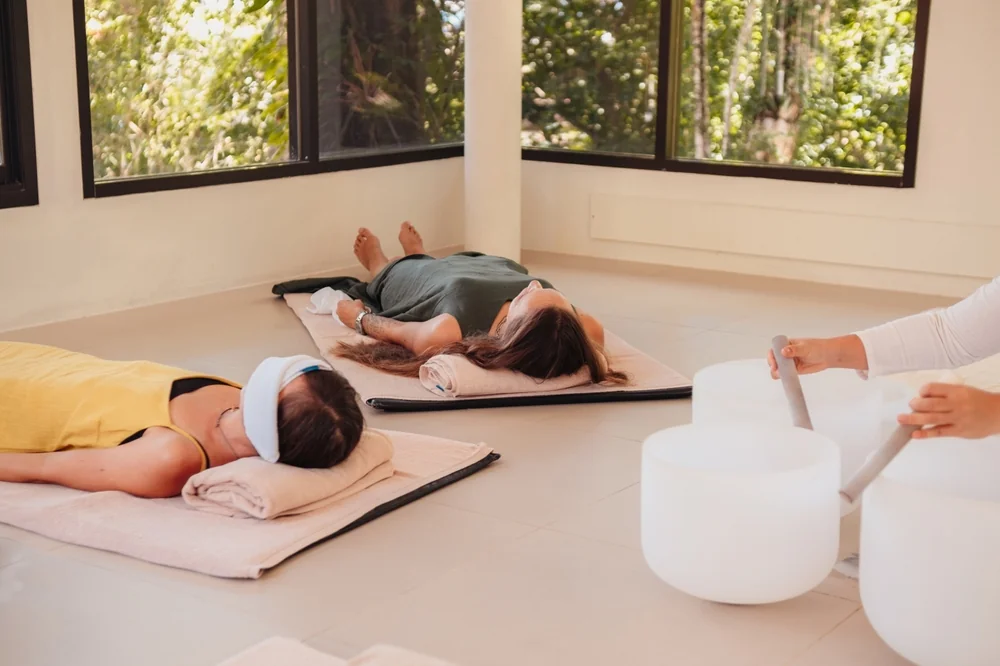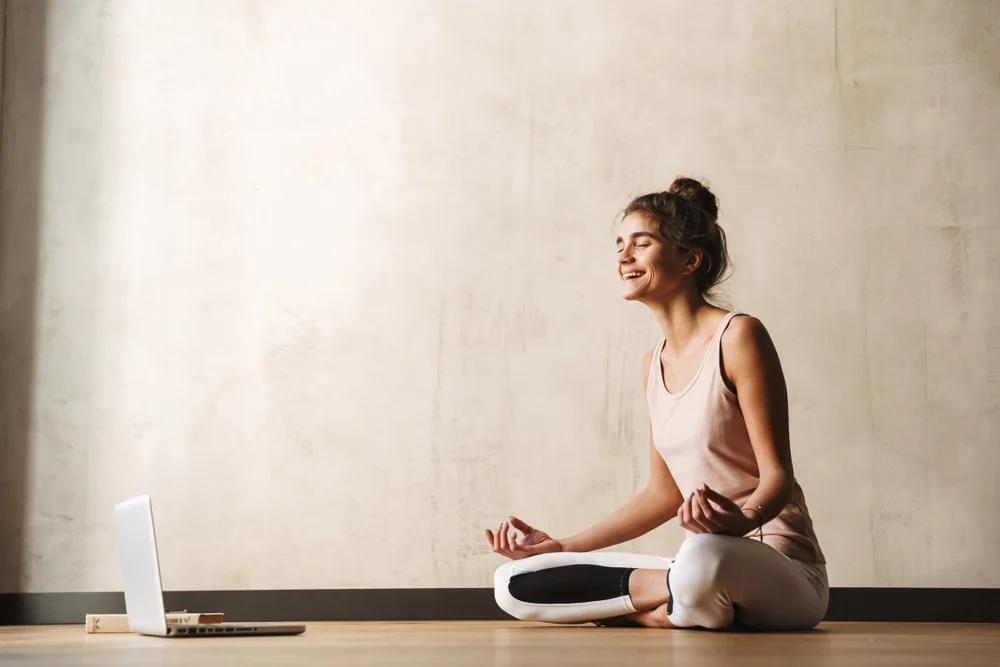What is a sound bath? A sound bath is a guided meditative experience where participants are immersed in soothing sounds and vibrations. These sessions typically use instruments such as singing bowls, gongs, and chimes to create a calming environment that helps the mind and body unwind.
Although sound baths have been practised for centuries in various cultural forms, they have gained widespread attention in recent years for their potential to support mental clarity, reduce stress, and improve sleep. As a non-invasive and accessible wellness method, many people now include sound baths as part of their regular self-care routine.
This article explores what a sound bath involves, how it works, who it may benefit, potential drawbacks, and how to experience one yourself, whether in a group setting, at home, or under professional guidance.
What Is a Sound Bath: The Origins
To truly understand what a sound bath is, it helps to explore its roots. The use of sound for healing dates back thousands of years across civilisations in Asia, the Middle East, and Indigenous cultures.
Tibetan monks have long used singing bowls in meditation, believing the vibrations help clear energy blockages. Similarly, ancient Indian traditions use mantras and chants to balance the chakras, while Aboriginal Australians have employed the didgeridoo for ceremonial healing.
These practices were grounded in the belief that sound, as vibration, can influence the body on a cellular level. Modern sound baths draw inspiration from these traditions, adapted into contemporary wellness practices that emphasise rest, balance, and emotional clarity.
What Happens During a Sound Bath?
A sound bath is not a literal bath with water, but a meditative experience where participants are “bathed” in sound waves generated by various instruments. These vibrations interact with the body and mind to promote deep relaxation and restoration.
The Setting
Sessions are typically held in calm, dimly lit spaces like yoga studios, wellness centres, or open-air venues. Participants lie down on mats or recline comfortably with blankets, eye masks, or cushions.

The Instruments
A range of sound bath instruments may be used, including:
- Singing bowls (also known as sound bath bowls), made of metal or crystal
- Gongs, which emit deep, resonant tones
- Chimes, tuning forks, and rain sticks
- Shamanic drums, rattles, and other ceremonial tools
These instruments emit frequencies believed to stimulate the parasympathetic nervous system, leading to a state of physical and mental calm.
The Facilitator’s Role
A trained sound therapist or facilitator guides the session, playing the instruments intuitively or following a specific sequence. The flow of sound is often continuous, layered, and carefully modulated to support meditative states and internal exploration.
What Does a Sound Bath Do?
At its core, a sound bath aims to restore balance across the mind, body, and energy systems. It is considered a form of sound therapy, with effects ranging from physiological to emotional.
Physical and Mental Benefits
Key sound bath benefits include:
- Reduced anxiety and stress
- Lowered blood pressure and heart rate
- Muscle relaxation and pain reduction
- Improved concentration and sleep
- Enhanced mood and emotional release
These outcomes make sound baths an appealing option for those looking for natural ways to manage stress and improve wellbeing.
Sound and Healing: The Science
Research suggests that sound can alter brainwave activity. Sound baths may promote alpha and theta brainwave states, associated with deep meditation, creativity, and restorative sleep.
This connection between sound and healing supports the idea that sound bath meditation can regulate the nervous system and promote a sense of inner balance, even for those unfamiliar with traditional meditation techniques.
Benefits for Specific Groups
Sound baths can support a wide range of people, including:
- Office workers: Helps counteract mental fatigue, physical tension, and tech overstimulation.
- People with insomnia: Encourages theta brainwave activity to promote restful sleep.
- Seniors: Offers gentle relaxation without physical exertion; may assist circulation and reduce anxiety.
- Individuals with anxiety or PTSD: Provides non-verbal, sensory-driven calming effects without direct confrontation of trauma.
Who Shouldn’t Do a Sound Bath?
While generally safe, sound baths may not be suitable for everyone. Some participants report temporary side effects such as:
- Headaches or dizziness
- Emotional sensitivity
- Overstimulation, especially in large group settings
These effects tend to be short-lived and manageable with proper aftercare.
When to Consult a Healthcare Provider
It is advisable to seek medical guidance before attending a sound bath if you:
- Have a pacemaker or implanted electronic device
- Experience epilepsy or sound-induced seizures
- Are in the first trimester of pregnancy
- Have a mental health condition affected by auditory or sensory input
Many facilitators are able to make adjustments, but personal safety should always take priority.
How to Experience a Sound Bath
If you’re ready to explore sound meditation, here are a few ways to get started:
In-Person Sessions
- Group sound baths: Ideal for community connection and affordability
- Private sessions: Tailored experiences suited to your personal energy or needs
Seek out certified sound therapists or wellness centres that specialise in sound healing.
Recorded Sound Bath Music
Platforms like YouTube, Spotify, and meditation apps offer a wide selection of sound bath music for home use. While not as immersive as in-person sessions, they’re still effective for regular stress relief.

DIY Sound Baths at Home
To create your own experience:
- Set up a quiet, comfortable space
- Play quality sound recordings or use real instruments if available
- Dim lights or add candles
- Include extras like essential oils or eye masks
- Use breathing techniques (e.g., 4-7-8 or box breathing) for grounding
What to Know Before You Go
Before attending a sound bath, it’s helpful to know what is a sound bath, what to expect and how to prepare. While the experience itself is calming and low-effort, a few practical considerations can make it more enjoyable and effective.
What Do You Wear to a Sound Bath?
What you wear can greatly influence your comfort level. The aim is to feel as relaxed and unrestricted as possible.
Recommended:
- Loose-fitting, breathable clothing
- Layers — body temperature can drop
- A shawl, hoodie, or socks for warmth
Avoid:
- Noisy fabrics (e.g. leather, stiff denim)
- Heavy accessories or jewellery
- Strong fragrances that might affect others
What Is the Etiquette for Sound Baths?
- Arrive 10–15 minutes early
- Turn off mobile devices
- Refrain from talking during the session
- Respect others’ physical space
- Bring anything that adds comfort (e.g. blanket, pillow, eye mask)
Is It Okay to Fall Asleep During a Sound Bath?
Yes — and it’s quite common. Falling asleep is often a sign that the body has reached a state of deep rest. Even in sleep, your body responds to the sound vibrations, and you may wake feeling more relaxed and refreshed.
Why Do I Feel Tired After a Sound Bath?
Feeling sleepy, dazed, or emotionally soft afterwards is a normal part of the process. The body may be releasing tension or entering a state of reset. It’s recommended to hydrate, rest, and avoid stimulation for a few hours post-session.
Do People Cry During Sound Baths?
Yes — and this is a natural response. The sound vibrations can stir emotional blockages, leading to tears or a sense of emotional release. This is often cathartic and part of the healing process. Most facilitators are experienced in holding space for such reactions.
What Are the Disadvantages of Sound Therapy?
Like any wellness practice, sound therapy has its limitations.
1. Scientific Uncertainty
While preliminary research supports the benefits of sound therapy, more clinical studies are needed. Its effectiveness can vary based on the individual, the setting, and the facilitator’s experience.
2. Emotional Vulnerability
Sound baths can sometimes surface intense emotions. Without appropriate support, this could feel overwhelming, especially for participants unprepared for an emotional release.
3. Over-Reliance
Some individuals may treat sound baths as a cure-all. It is best viewed as a complement to other health practices, not a standalone solution for complex medical or psychological concerns.
4. Sensory Sensitivity
People with heightened sound sensitivity or conditions like migraines may find certain frequencies uncomfortable or triggering.
Final Thoughts: Embracing the Power of Sound for Wellness
So, what is a sound bath? It is a gentle, immersive practice using sound to promote balance, calm, and healing. Whether you’re managing chronic stress, exploring mindfulness, or simply curious about holistic therapies, sound baths offer a grounding experience with benefits that extend beyond the session.
When approached with intention, it can support emotional wellbeing, nervous system regulation, and deeper rest — all without the need for complicated routines or equipment.
Continue Your Wellness Journey with OSIM
To continue reaping the benefits of sound-based relaxation at home, OSIM UK offers a curated range of innovative wellness solutions.
The uDream Pro massage chair combines AI wellness technology with aromatherapy and ambient sound features, making it ideal for replicating the immersive calm of a sound bath.
For those seeking more compact options, explore OSIM’s neck and shoulder massagers, foot massagers, and handheld devices, all designed to provide targeted relief when you need it most.
Each product is crafted to support your personal wellness journey, helping you create a restorative space wherever you are.Discover the full collection at OSIM and bring everyday calm into your life.




